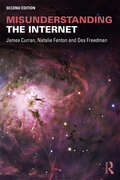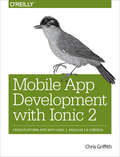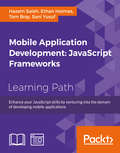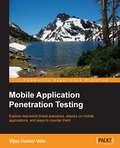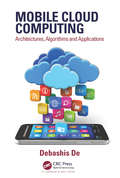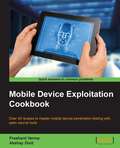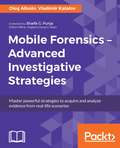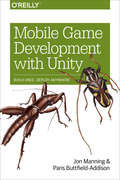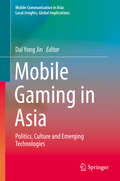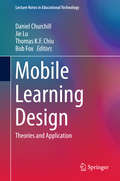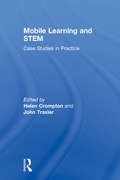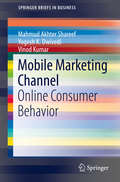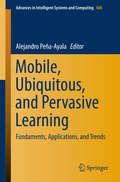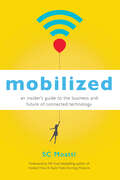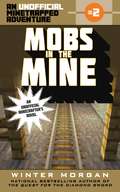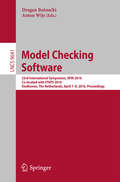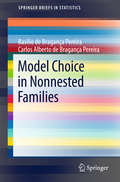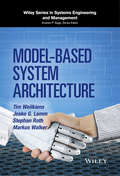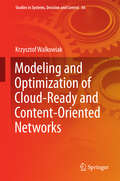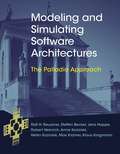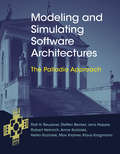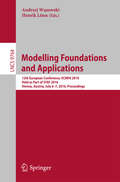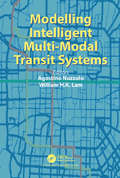- Table View
- List View
Misunderstanding the Internet (Communication and Society)
by James Curran Des Freedman Natalie FentonThe growth of the internet has been spectacular. There are now more than 3 billion internet users across the globe, some 40 per cent of the world’s population. The internet’s meteoric rise is a phenomenon of enormous significance for the economic, political and social life of contemporary societies. However, much popular and academic writing about the internet continues to take a celebratory view, assuming that the internet’s potential will be realised in essentially positive and transformative ways. This was especially true in the euphoric moment of the mid-1990s, when many commentators wrote about the internet with awe and wonderment. While this moment may be over, its underlying technocentrism – the belief that technology determines outcomes – lingers on and, with it, a failure to understand the internet in its social, economic and political contexts. Misunderstanding the Internet is a short introduction, encompassing the history, sociology, politics and economics of the internet and its impact on society. This expanded and updated second edition is a polemical, sociologically and historically informed guide to the key claims that have been made about the online world. It aims to challenge both popular myths and existing academic orthodoxies that surround the internet.
Mobile App Development with Ionic 2: Cross-Platform Apps with Ionic, Angular, and Cordova
by Chris GriffithLearn how to build app store-ready hybrid apps with the Ionic 2, the framework built on top of Apache Cordova (formerly PhoneGap) and Angular. This practical guide shows you how to use Ionic’s tools and services to develop apps with HTML, CSS, and TypeScript, rather than rely on platform-specific solutions found in Android, iOS, and Windows Phone.Author Chris Griffith takes you step-by-step through Ionic’s powerful collection of UI components, and then helps you use it to build three cross-platform mobile apps. Whether you’re new to this framework or have been working with Ionic 1, this book is ideal for beginning, intermediate, and advanced web developers.Understand what a hybrid mobile app is, and what comprises a basic Ionic applicationLearn how Ionic leverages Apache Cordova, Angular, and TypeScript to create native mobile applicationsCreate a Firebase-enabled to-do application that stores data across multiple clientsBuild a tab-based National Park explorer app with Google Map integrationDevelop a weather app with the Darksky weather API and Google’s GeoCode APIDebug and test your app to resolve issues that arise during developmentWalk through steps for deploying your app to native app storesLearn how Ionic can be used to create Progressive Web Apps
Mobile Application Development: Using JavaScript Descendent Technologies
by Hazem Saleh Tom Bray Ethan Holmes Sani YusufEnhance your JavaScript skills by venturing into the domain of developing mobile applications About This Book * Extend your JavaScript skillset to build, test, and launch mobile apps with confidence * Follow three sample projects to experience Ionic's impressive capabilities * Extend the power of Apache Cordova by creating your own Apache Cordova cross-platform mobile plugins Who This Book Is For This Learning Path is for JavaScript web developers looking to develop mobile applications using various JavaScript descendent technologies. It is for anyone who wants to learn how to build fast and stylish native mobile app using the skills they already have. If you are already using React on the web, we're confident you'll be able to quickly get up and running with React Native for iOS and Android. See Ionic in action, and find out how it can transform the way you build mobile apps. What You Will Learn * Develop, build, run, and deploy great cross-platform mobile applications using Apache Cordova * Create complete mobile apps using Apache Cordova that runs on Apple iOS, Google Android, and Windows Phone * Create a neat user interface for your mobile application using jQuery Mobile * Gain an in-depth understanding of how React Native works behind the scenes * Write your own custom native UI components * Develop native modules in Objective-C and Java that interact with JavaScript * Get to know Ionic by creating three complete mobile applications In Detail A great mobile app is rapidly becoming crucial for a huge range of businesses. With a great app, your customers or your readers don't come to you - you go with them, just a few clicks and swipes away. This Learning Path shows you how to build awesome mobile apps with some of the best tools currently being used by some of the smartest developers in the industry. Taking you through JavaScript impressive development ecosystem - from jQuery Mobile to React, through to Ionic - we'll show you how to put your skills into practice so you can build your next mobile apps with confidence and style. In this Learning Path, from jQuery to React, to Ionic, we'll cover everything you need to start In the first module you'll learn how to get stuck into Apache Cordova and find out how to use it as the key platform for developing your mobile app. It offers an efficient way to develop hybrid apps, which means you won't have to connect to platform specific APIs or use their UI framework, and can instead harness your JavaScript web development skills. Make sure you have your HTML, CSS and jQuery skills at the ready. In Module 2 we'll show you how to take advantage of React Native. It has a reputation for having a steep learning curve, but we'll make it easy for you, making sure you make full use of your existing knowledge and getting you up and running with a sample application. You'll also learn how to create components, how to create multiple screens, as well as using native UI components and accessing native APIs. In the third and final module you'll get started with Ionic. With three practical projects you can build yourself, we've made sure that you'll be learning by doing - which means you'll not only develop new skills much more quickly, but you'll have produced something tangible at the end of it! This Learning Path combines some of the best that Packt has to offer in one complete, curated package. It includes content from the following Packt products: * JavaScript Mobile Application Development by Hazem Saleh * Getting Started with React Native by Ethan Holmes and Tom Bray * Ionic Framework By Example by Sani Yusuf Style and approach This Learning Path course provides a simple and easy way to build mobile applications in JavaScript descendent technologies such as jQuery, ReactJS, and Ionic.
Mobile Application Penetration Testing
by Vijay Kumar VeluExplore real-world threat scenarios, attacks on mobile applications, and ways to counter them About This Book * Gain insights into the current threat landscape of mobile applications in particular * Explore the different options that are available on mobile platforms and prevent circumventions made by attackers * This is a step-by-step guide to setting up your own mobile penetration testing environment Who This Book Is For If you are a mobile application evangelist, mobile application developer, information security practitioner, penetration tester on infrastructure web applications, an application security professional, or someone who wants to learn mobile application security as a career, then this book is for you. This book will provide you with all the skills you need to get started with Android and iOS pen-testing. What You Will Learn * Gain an in-depth understanding of Android and iOS architecture and the latest changes * Discover how to work with different tool suites to assess any application * Develop different strategies and techniques to connect to a mobile device * Create a foundation for mobile application security principles * Grasp techniques to attack different components of an Android device and the different functionalities of an iOS device * Get to know secure development strategies for both iOS and Android applications * Gain an understanding of threat modeling mobile applications * Get an in-depth understanding of both Android and iOS implementation vulnerabilities and how to provide counter-measures while developing a mobile app In Detail Mobile security has come a long way over the last few years. It has transitioned from "should it be done?" to "it must be done!"Alongside the growing number of devises and applications, there is also a growth in the volume of Personally identifiable information (PII), Financial Data, and much more. This data needs to be secured. This is why Pen-testing is so important to modern application developers. You need to know how to secure user data, and find vulnerabilities and loopholes in your application that might lead to security breaches. This book gives you the necessary skills to security test your mobile applications as a beginner, developer, or security practitioner. You'll start by discovering the internal components of an Android and an iOS application. Moving ahead, you'll understand the inter-process working of these applications. Then you'll set up a test environment for this application using various tools to identify the loopholes and vulnerabilities in the structure of the applications. Finally, after collecting all information about these security loop holes, we'll start securing our applications from these threats. Style and approach This is an easy-to-follow guide full of hands-on examples of real-world attack simulations. Each topic is explained in context with respect to testing, and for the more inquisitive, there are more details on the concepts and techniques used for different platforms.
Mobile Cloud Computing: Architectures, Algorithms and Applications
by Debashis DeMinimize Power Consumption and Enhance User ExperienceEssential for high-speed fifth-generation mobile networks, mobile cloud computing (MCC) integrates the power of cloud data centers with the portability of mobile computing devices. Mobile Cloud Computing: Architectures, Algorithms and Applications covers the latest technological and architectura
Mobile Device Exploitation Cookbook
by Akshay Dixit Prashant Kumar VermaThis book is intended for mobile security enthusiasts and penetration testers who wish to secure mobile devices to prevent attacks and discover vulnerabilities to protect devices.
Mobile Forensics: Advanced Investigative Strategies
by Oleg Afonin Vladimir KatalovMaster powerful strategies to acquire and analyze evidence from real-life scenariosAbout This BookA straightforward guide to address the roadblocks face when doing mobile forensicsSimplify mobile forensics using the right mix of methods, techniques, and toolsGet valuable advice to put you in the mindset of a forensic professional, regardless of your career level or experienceWho This Book Is ForThis book is for forensic analysts and law enforcement and IT security officers who have to deal with digital evidence as part of their daily job. Some basic familiarity with digital forensics is assumed, but no experience with mobile forensics is required.What You Will LearnUnderstand the challenges of mobile forensicsGrasp how to properly deal with digital evidenceExplore the types of evidence available on iOS, Android, Windows, and BlackBerry mobile devicesKnow what forensic outcome to expect under given circumstancesDeduce when and how to apply physical, logical, over-the-air, or low-level (advanced) acquisition methodsGet in-depth knowledge of the different acquisition methods for all major mobile platformsDiscover important mobile acquisition tools and techniques for all of the major platformsIn DetailInvestigating digital media is impossible without forensic tools. Dealing with complex forensic problems requires the use of dedicated tools, and even more importantly, the right strategies. In this book, you'll learn strategies and methods to deal with information stored on smartphones and tablets and see how to put the right tools to work.We begin by helping you understand the concept of mobile devices as a source of valuable evidence. Throughout this book, you will explore strategies and "plays" and decide when to use each technique. We cover important techniques such as seizing techniques to shield the device, and acquisition techniques including physical acquisition (via a USB connection), logical acquisition via data backups, over-the-air acquisition. We also explore cloud analysis, evidence discovery and data analysis, tools for mobile forensics, and tools to help you discover and analyze evidence.By the end of the book, you will have a better understanding of the tools and methods used to deal with the challenges of acquiring, preserving, and extracting evidence stored on smartphones, tablets, and the cloud.
Mobile Game Development with Unity: Build Once, Deploy Anywhere
by Paris Buttfield-Addison Jonathon ManningDo you want to build mobile games, but lack game development experience? No problem. This practical guide shows you how to create beautiful, interactive content for iOS and Android devices with the Unity game engine.Authors Jon Manning and Paris Buttfield-Addison (iOS Swift Game Development Cookbook) provide a top-to-bottom overview of Unity’s features with specific, project-oriented guidance on how to use them in real game situations. Over the course of this book, you’ll learn hands-on how to build 2D and 3D games from scratch that will hook and delight players. If you have basic programming skills, you’re ready to get started.Explore the basics of Unity, and learn how to structure games, graphics, scripting, sounds, physics, and particle systemsUse 2D graphics and physics features to build a side-scrolling action gameCreate a 3D space combat simulator with projectile shooting and respawning objects, and learn how to manage the appearance of 3D modelsDive into Unity’s advanced features, such as precomputed lighting, shading, customizing the editor, and deployment
Mobile Gaming in Asia
by Dal Yong JinThis book analyzes mobile gaming in the Asian context and looks into a hitherto neglected focus of inquiry - a localized mobile landscape, with particular reference to young Asians' engagement with mobile gaming. This edition focuses not only on the remarkable success of local mobile games, but also on the significance of social milieu in the development of Asian mobile technologies and gaming culture. It analyzes the growth of the current mobile technologies and mobile gaming not as separate but as continuous developments in tandem with the digital economy. It is of interest to both academics and a broader readership from the business, government, and information technology sectors
Mobile Learning Design
by Bob Fox Daniel Churchill Jie Lu Thomas K.F. ChiuThis book focuses on mobile learning design from both theoretical and practical perspectives. It introduces and discusses how mobile learning can be effectively integrated into curricula, highlighting the design of four key components of learning-centric pedagogy: Resource, Activity, Support and Evaluation in the context of mobile learning. It also investigates the learning theories underpinning mobile learning design, and includes case studies in different contexts. It provides practical insights that allow teachers to change and transform teaching practices using mobile technology. Anyone involved in mobile-technology enhanced learning and teaching will find this book both informative and useful.
Mobile Learning and STEM: Case Studies in Practice
by Helen Crompton John TraxlerIn recent years, there has been a renewed focus on STEM education in the United States, fueled by evidence that young learners’ competencies in science, technology, engineering, and mathematics are falling behind those of their global peers. Scholars and practitioners are beginning to utilize the new pedagogical opportunities offered by mobile learning to improve the successes of teachers and K-12 students across STEM subjects. Mobile Learning and STEM: Case Studies in Practice is a comprehensive collection of case studies that explore mobile learning’s support of STEM subjects and that utilize mobile technology to facilitate unique and effective K-12 teaching and learning experiences. In addition to its focus on STEM achievement for researchers, this volume is a resource for teachers working to implement mobile learning initiatives into their classrooms. Mobile Learning and STEM also includes research that is applicable to classrooms in nations around the world, where few students from underrepresented racial and socioeconomic backgrounds are entering into STEM jobs. Concluding with a summary of its research and its implications to future scholarship and practice, this book is a springboard for practitioners, specialists, higher education instructors, and researchers who want to establish better practices in schools and raise student achievement in STEM subjects.
Mobile Marketing Channel
by Yogesh K. Dwivedi Mahmud Akhter Shareef Vinod KumarThis book attempts to address, explore, and conceptualize the epistemological paradigms of SMS as an alternative marketing channel or in combination with other existing traditional channels. It promotes a multichannel strategy in the light of synthesized marketing distribution, consumer behavior, and information and communication technology (ICT)-related behavioral theory to develop, establish, and launch a guiding theory and practice for this emerging area. Usage of mobile phones and hand-held wireless devices is growing and diffusing so quickly that 21st century marketing managers find a great potential for this wireless channel to be the most effective media for maintaining a consumer relationship that provides the highest quality service. The emergence of SMS-based direct marketing as a distinct channel or embedded with other channels is characterized by several issues, challenges, barriers, and limitations. This book examines and postulates the following interrelated issues related to wireless marketing (particularly the SMS-based marketing channel): (i) Consumer behavior for mobile phone SMS - perception, exposure, and attention; (ii) Consumer attitudes toward SMS-based marketing channels; (iii) The scope of SMS to meet consumer service output demands from an online channel; (iv) Consumer selection criteria for mobile phone SMS channel structure; (v) Mobile channel structure as an efficient and effective consumer interaction mode; and (vi) Consumer multichannel behavior. It is important to use the SMS-based mobile channel as a radical tool of interactive marketing and seamless service marketing, as there is the opportunity to maximize, u ntil now, unutilized benefits of this efficient and popular direct marketing channel.
Mobile, Ubiquitous, and Pervasive Learning
by Alejandro Peña-AyalaThis book is concerned with the mobile, ubiquitous,and pervasive learning arena. Itpresent a collection of works corresponding to four categories: reviews,studies, conceptual proposals, and approaches. As a result of the submissionand revision processes eight manuscripts were accepted and organized into theaforementioned four parts as follows: ·Review: a couple of chapters offer asurvey of related works. One concerns with the diversity of mobile, ubiquitous,and pervasive labor, where interested findings are unveiled based oncorrelations. Other focuses on adaptive and adaptable architectures that aresuitable to implement ubiquitous learning sceneries, whose contributionrepresents a model of a domain specific architecture. ·Studies: two chapters explore issuesrelated to the effect of question styles made through smartphones and tablets,and the disposition of teachers to exploit mobile devices at classroom. ·Conceptual: a pair of chapters offer agiven proposal, the first to develop adaptive mobile learning systems by meansof a framework based on contextual information; and the second with the purposeto share some guidelines of how to apply cloud computing in the development andoperation of mobile. ·Approaches: two chapters apply aspecific paradigm as part of a whole application and reveal the achievedimpact. One of them uses augmented reality to encourage children to learn abouttrees as context-sensitive informal learning. The other, immerses children inplaying a learning game to learn math by cooperating between members team andinteracting through mobile devices. This volume will be a source of interest forresearchers, practitioners, professors, and postgraduate students aimed atupdating their knowledge and finding targets for future work in the mobile,ubiquitous, and pervasive learning field!
Mobilized: An Insider’s Guide to the Business and Future of Connected Technology
by SC MoattiMobile has now become such an integral part of how we live that, for many people, losing a cell phone is like losing a limb. Everybody knows mobile is the future, and every business wants in, but what are the elements of mobile success? SC Moatti, a Silicon Valley veteran who was an executive with Facebook, Trulia, and Nokia, gives businesses and professionals simple ways to thrive in this modern day "gold rush." More than a book on technology, this is a book about human nature and what matters most to us. Moatti shows that because mobile products have become extensions of ourselves, we expect from them what we wish for ourselves: an attractive body, a meaningful life, and a growing repertoire of skills. She has created an all-encompassing formula that makes it easy for any business to develop a strategy for creating winning mobile products.Her Body Rule dictates that mobile products must appeal to our sense of beauty—but beauty in a mobile world is both similar to and different from what it means offline. The Spirit Rule says mobile products must help us address our deepest personal needs. And the Mind Rule explains that businesses that want to succeed in mobile need to continually analyze the user experience so they can improve every iteration of their products. Moatti includes case studies from mobile pioneers such as Facebook, Uber, Tinder, WhatsApp, and more. The market is full of how-to books for programming apps, but no works examine what is required for success in the mobile era. Until now.
Mobs in the Mine (The Unofficial Minetrapped Adventure #2)
by Winter MorganLily, Simon, and Michael are still trapped in their Minecraft game, but with new friends and a better understanding of their arch enemy Mr. Anarchy, they’re getting closer to finding a way home. But before they can fight the evil griefer and escape the game, the friends need to replenish their resources-and that means trekking deeper into the Overworld.When their mining party is attacked and hostile mobs reveal surprising new powers, it looks like the end for the trio-and for all their friends in town. Will Lily, Simon, and Michael find a way to defeat the mobs and save their village? Will they ever conquer Mr. Anarchy and escape from the Overworld?Find out in this exciting, action-packed second book in the Unofficial Minetrapped Adventures series by bestselling author Winter Morgan.Sky Pony Press, with our Good Books, Racehorse and Arcade imprints, is proud to publish a broad range of books for young readers-picture books for small children, chapter books, books for middle grade readers, and novels for young adults. Our list includes bestsellers for children who love to play Minecraft; stories told with LEGO bricks; books that teach lessons about tolerance, patience, and the environment, and much more. While not every title we publish becomes a New York Times bestseller or a national bestseller, we are committed to books on subjects that are sometimes overlooked and to authors whose work might not otherwise find a home.
Model Checking Software
by Dragan Bošnački Anton WijsThis bookconstitutes the refereed proceedings of the 23rd International Symposium on ModelChecking Software, SPIN 2016, held in Eindhoven, The Netherlands, in April 2016. The 16 papers presented, consisting of 11 regular papers, 1 idea paper, and 4tool demonstrations, were carefully reviewed and selected from 27 submissions. Topics covered include model checking techniques, model checking tools, concurrent system semantics, equivalence checking, temporal logics, probabilistic systems, schedule and strategy synthesis using model checking, and verification case studies.
Model Choice in Nonnested Families
by Basilio De Pereira Carlos Alberto PereiraThis book discusses the problem of model choice when the statistical models are separate, also called nonnested. Chapter 1 provides an introduction, motivating examples and a general overview of the problem. Chapter 2 presents the classical or frequentist approach to the problem as well as several alternative procedures and their properties. Chapter 3 explores the Bayesian approach, the limitations of the classical Bayes factors and the proposed alternative Bayes factors to overcome these limitations. It also discusses a significance Bayesian procedure. Lastly, Chapter 4 examines the pure likelihood approach. Various real-data examples and computer simulations are provided throughout the text.
Model-Based System Architecture
by Stephan Roth Tim Weilkiens Jesko G. Lamm Markus WalkerPresents modeling approaches that can be performed in SysML and other modeling languages This book combines the emerging discipline of systems architecting with model-based approaches using SysML. The early chapters of the book provide the fundamentals of systems architecting; discussing what systems architecting entails and how it benefits systems engineering. Model-based systems engineering is then defined, and its capabilities to develop complex systems on time and in a feasible quality are discussed. The remainder of the book covers important topics such as: architecture descriptions; architecture patterns; perspectives, viewpoints, views and their relation to system architecture; the roles of a system architect, their team, and stakeholders; systems architecting processes; agile approaches to systems architecting; variant modeling techniques; architecture frameworks; and architecture assessment. The book's organization allows experts to read the chapters out of sequence. Novices can read the chapters sequentially to gain a systematic introduction to system architecting. Model-Based System Architecture: Provides comprehensive coverage of the Functional Architecture for Systems (FAS) method created by the authors and based on common MBSE practices Covers architecture frameworks, including the System of Systems, Zachman Frameworks, TOGAF®, and more Includes a consistent example system, the "Virtual Museum Tour" system, that allows the authors to demonstrate the systems architecting concepts covered in the book Model-Based System Architecture is a comprehensive reference for system architects and systems engineers in technology companies. This book will also serve as a reference to students and researchers interested in functional architectures. Tim Weilkiens is the CEO at the German consultancy oose Innovative Informatik and co-author of the SysML specification. He has introduced model-based systems engineering to a variety of industry sectors. He is author of several books about modeling and the MBSE methodology SYSMOD. Jesko G. Lamm is a Senior Systems Engineer at Bernafon, a Swiss manufacturer for hearing instruments. With Tim Weilkiens, Jesko G. Lamm founded the Functional Architectures working group of the German chapter of INCOSE. Stephan Roth is a coach, consultant, and trainer for systems and software engineering at the German consultancy oose Innovative Informatik. He is a state-certified technical assistant for computer science from Physikalisch-Technische Lehranstalt (PTL) Wedel and a certified systems engineer (GfSE)®- Level C. Markus Walker works at Schindler Elevator in the research and development division as elevator system architect. He is an INCOSE Certified Systems Engineering Professional (CSEP) and is engaged in the committee of the Swiss chapter of INCOSE.
Model-Based Systems Engineering with OPM and SysML
by Dov DoriModel-Based Systems Engineering (MBSE), which tackles architecting and design of complex systems through the use of formal models, is emerging as the most critical component of systems engineering. This textbook specifies the two leading conceptual modeling languages, OPM--the new ISO 19450, composed primarily by the author of this book, and OMG SysML. It provides essential insights into a domain-independent, discipline-crossing methodology of developing or researching complex systems of any conceivable kind and size. Combining theory with a host of industrial, biological, and daily life examples, the book explains principles and provides guidelines for architecting complex, multidisciplinary systems, making it an indispensable resource for systems architects and designers, engineers of any discipline, executives at all levels, project managers, IT professional, systems scientists, and engineering students.
Modeling and Optimization of Cloud-Ready and Content-Oriented Networks
by Krzysztof WalkowiakThisbook focuses on modeling and optimization of cloud-ready and content-orientednetworks in the context of different layers and accounts for specificconstraints following from protocols andtechnologies used in a particular layer. It addresses a wide range ofadditional constraints importantin contemporary networks, including various types of network flows,survivability issues, multi-layer networking, and resource location. Thebook presents recent existing and new results in a comprehensive and cohesiveway. The contents of the book are organized in five chapters, which are mostlyself-contained. Chapter 1 briefly presents information oncloud computing and content-oriented services, and introduces basic notionsand concepts of network modeling and optimization. Chapter 2 covers various optimizationproblems that arise in the context of connection-oriented networks. Chapter3 focuses on modeling and optimization of Elastic Optical Networks. Chapter 4 isdevoted to overlay networks. The book concludes with Chapter 5, summarizing thebook and present recent research trends in the field of network optimization.
Modeling and Optimization of Parallel and Distributed Embedded Systems
by Sanjay Ranka Ann Gordon-Ross Arslan MunirThis book introduces the state-of-the-art in research in parallel and distributed embedded systems, which have been enabled by developments in silicon technology, micro-electro-mechanical systems (MEMS), wireless communications, computer networking, and digital electronics. These systems have diverse applications in domains including military and defense, medical, automotive, and unmanned autonomous vehicles. The emphasis of the book is on the modeling and optimization of emerging parallel and distributed embedded systems in relation to the three key design metrics of performance, power and dependability. Key features: Includes an embedded wireless sensor networks case study to help illustrate the modeling and optimization of distributed embedded systems. Provides an analysis of multi-core/many-core based embedded systems to explain the modeling and optimization of parallel embedded systems. Features an application metrics estimation model; Markov modeling for fault tolerance and analysis; and queueing theoretic modeling for performance evaluation. Discusses optimization approaches for distributed wireless sensor networks; high-performance and energy-efficient techniques at the architecture, middleware and software levels for parallel multicore-based embedded systems; and dynamic optimization methodologies. Highlights research challenges and future research directions. The book is primarily aimed at researchers in embedded systems; however, it will also serve as an invaluable reference to senior undergraduate and graduate students with an interest in embedded systems research.
Modeling and Simulating Software Architectures: The Palladio Approach
by Heiko Koziolek Robert Heinrich Max Kramer Jens Happe Ralf H. Reussner Klaus Krogmann Steffen Becker Anne KoziolekToo often, software designers lack an understanding of the effect of design decisions on such quality attributes as performance and reliability. This necessitates costly trial-and-error testing cycles, delaying or complicating rollout. This book presents a new, quantitative architecture simulation approach to software design, which allows software engineers to model quality of service in early design stages. It presents the first simulator for software architectures, Palladio, and shows students and professionals how to model reusable, parametrized components and configured, deployed systems in order to analyze service attributes.The text details the key concepts of Palladio's domain-specific modeling language for software architecture quality and presents the corresponding development stage. It describes how quality information can be used to calibrate architecture models from which detailed simulation models are automatically derived for quality predictions. Readers will learn how to approach systematically questions about scalability, hardware resources, and efficiency. The text features a running example to illustrate tasks and methods as well as three case studies from industry. Each chapter ends with exercises, suggestions for further reading, and "takeaways" that summarize the key points of the chapter. The simulator can be downloaded from a companion website, which offers additional material. The book can be used in graduate courses on software architecture, quality engineering, or performance engineering. It will also be an essential resource for software architects and software engineers and for practitioners who want to apply Palladio in industrial settings.
Modeling and Simulating Software Architectures: The Palladio Approach
by Robert Heinrich Jens Happe Ralf H. Reussner Steffen Becker Anne KoziolekA new, quantitative architecture simulation approach to software design that circumvents costly testing cycles by modeling quality of service in early design states.Too often, software designers lack an understanding of the effect of design decisions on such quality attributes as performance and reliability. This necessitates costly trial-and-error testing cycles, delaying or complicating rollout. This book presents a new, quantitative architecture simulation approach to software design, which allows software engineers to model quality of service in early design stages. It presents the first simulator for software architectures, Palladio, and shows students and professionals how to model reusable, parametrized components and configured, deployed systems in order to analyze service attributes.The text details the key concepts of Palladio's domain-specific modeling language for software architecture quality and presents the corresponding development stage. It describes how quality information can be used to calibrate architecture models from which detailed simulation models are automatically derived for quality predictions. Readers will learn how to approach systematically questions about scalability, hardware resources, and efficiency. The text features a running example to illustrate tasks and methods as well as three case studies from industry. Each chapter ends with exercises, suggestions for further reading, and “takeaways” that summarize the key points of the chapter. The simulator can be downloaded from a companion website, which offers additional material. The book can be used in graduate courses on software architecture, quality engineering, or performance engineering. It will also be an essential resource for software architects and software engineers and for practitioners who want to apply Palladio in industrial settings.
Modelling Foundations and Applications
by Andrzej Wąsowski Henrik LönnThis book constitutes the proceedings of the 12th European Conference on Modelling Foundations and Applications, ECMFA 2016, held as part of STAF 2016, in Vienna, Austria, in July 2016. The 16 papers presented in this volume were carefully reviewed and selected from 47 submissions. The committee decided to accept 16 papers, 12 papers for the Foundations Track and 4 papers for the Applications Track. Papers on a wide range of MBE aspects were accepted, including topics such as multi- and many models, language engineering, UML and meta-modeling, experience reports and case studies, and variability and uncertainty.
Modelling Intelligent Multi-Modal Transit Systems
by Agostino Nuzzolo William H. LamThe growing mobility needs of travellers have led to the development of increasingly complex and integrated multi-modal transit networks. Hence, transport agencies and transit operators are now more urgently required to assist in the challenging task of effectively and efficiently planning, managing, and governing transit networks. A pre-condition for the development of an effective intelligent multi-modal transit system is the integration of information and communication technology (ICT) tools that will support the needs of transit operators and travellers. To achieve this, reliable real-time simulation and short-term forecasting of passenger demand and service network conditions are required to provide both real-time traveller information and successfully synchronise transit service planning and operations control. Modelling Intelligent Multi-Modal Transit Systems introduces the current trends in this newly emerging area. Recent developments in information technology and telematics have enabled a large amount of data to become available, thus further attracting transport researchers to set up new models outside the context of the traditional data-driven approach. The alternative demand-supply interaction or network assignment modelling approach has improved greatly in recent years and has a crucial role to play in this new context.
